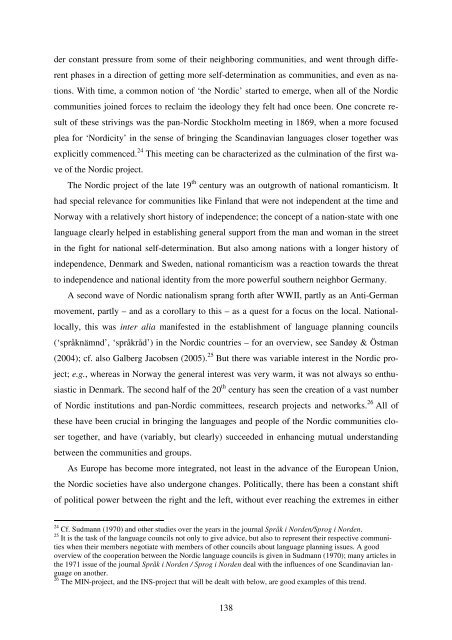Hør dog hvad de siger - Note-to-Self: Trials & Errors
Hør dog hvad de siger - Note-to-Self: Trials & Errors
Hør dog hvad de siger - Note-to-Self: Trials & Errors
Create successful ePaper yourself
Turn your PDF publications into a flip-book with our unique Google optimized e-Paper software.
<strong>de</strong>r constant pressure from some of their neighboring communities, and went through diffe-<br />
rent phases in a direction of getting more self-<strong>de</strong>termination as communities, and even as na-<br />
tions. With time, a common notion of ‘the Nordic’ started <strong>to</strong> emerge, when all of the Nordic<br />
communities joined forces <strong>to</strong> reclaim the i<strong>de</strong>ology they felt had once been. One concrete re-<br />
sult of these strivings was the pan-Nordic S<strong>to</strong>ckholm meeting in 1869, when a more focused<br />
plea for ‘Nordicity’ in the sense of bringing the Scandinavian languages closer <strong>to</strong>gether was<br />
explicitly commenced. 24 This meeting can be characterized as the culmination of the first wa-<br />
ve of the Nordic project.<br />
The Nordic project of the late 19 th century was an outgrowth of national romanticism. It<br />
had special relevance for communities like Finland that were not in<strong>de</strong>pen<strong>de</strong>nt at the time and<br />
Norway with a relatively short his<strong>to</strong>ry of in<strong>de</strong>pen<strong>de</strong>nce; the concept of a nation-state with one<br />
language clearly helped in establishing general support from the man and woman in the street<br />
in the fight for national self-<strong>de</strong>termination. But also among nations with a longer his<strong>to</strong>ry of<br />
in<strong>de</strong>pen<strong>de</strong>nce, Denmark and Swe<strong>de</strong>n, national romanticism was a reaction <strong>to</strong>wards the threat<br />
<strong>to</strong> in<strong>de</strong>pen<strong>de</strong>nce and national i<strong>de</strong>ntity from the more powerful southern neighbor Germany.<br />
A second wave of Nordic nationalism sprang forth after WWII, partly as an Anti-German<br />
movement, partly – and as a corollary <strong>to</strong> this – as a quest for a focus on the local. National-<br />
locally, this was inter alia manifested in the establishment of language planning councils<br />
(‘språknämnd’, ‘språkråd’) in the Nordic countries – for an overview, see Sandøy & Östman<br />
(2004); cf. also Galberg Jacobsen (2005). 25 But there was variable interest in the Nordic pro-<br />
ject; e.g., whereas in Norway the general interest was very warm, it was not always so enthu-<br />
siastic in Denmark. The second half of the 20 th century has seen the creation of a vast number<br />
of Nordic institutions and pan-Nordic committees, research projects and networks. 26 All of<br />
these have been crucial in bringing the languages and people of the Nordic communities clo-<br />
ser <strong>to</strong>gether, and have (variably, but clearly) succee<strong>de</strong>d in enhancing mutual un<strong>de</strong>rstanding<br />
between the communities and groups.<br />
As Europe has become more integrated, not least in the advance of the European Union,<br />
the Nordic societies have also un<strong>de</strong>rgone changes. Politically, there has been a constant shift<br />
of political power between the right and the left, without ever reaching the extremes in either<br />
24 Cf. Sudmann (1970) and other studies over the years in the journal Språk i Nor<strong>de</strong>n/Sprog i Nor<strong>de</strong>n.<br />
25 It is the task of the language councils not only <strong>to</strong> give advice, but also <strong>to</strong> represent their respective communities<br />
when their members negotiate with members of other councils about language planning issues. A good<br />
overview of the cooperation between the Nordic language councils is given in Sudmann (1970); many articles in<br />
the 1971 issue of the journal Språk i Nor<strong>de</strong>n / Sprog i Nor<strong>de</strong>n <strong>de</strong>al with the influences of one Scandinavian language<br />
on another.<br />
26 The MIN-project, and the INS-project that will be <strong>de</strong>alt with below, are good examples of this trend.<br />
138



